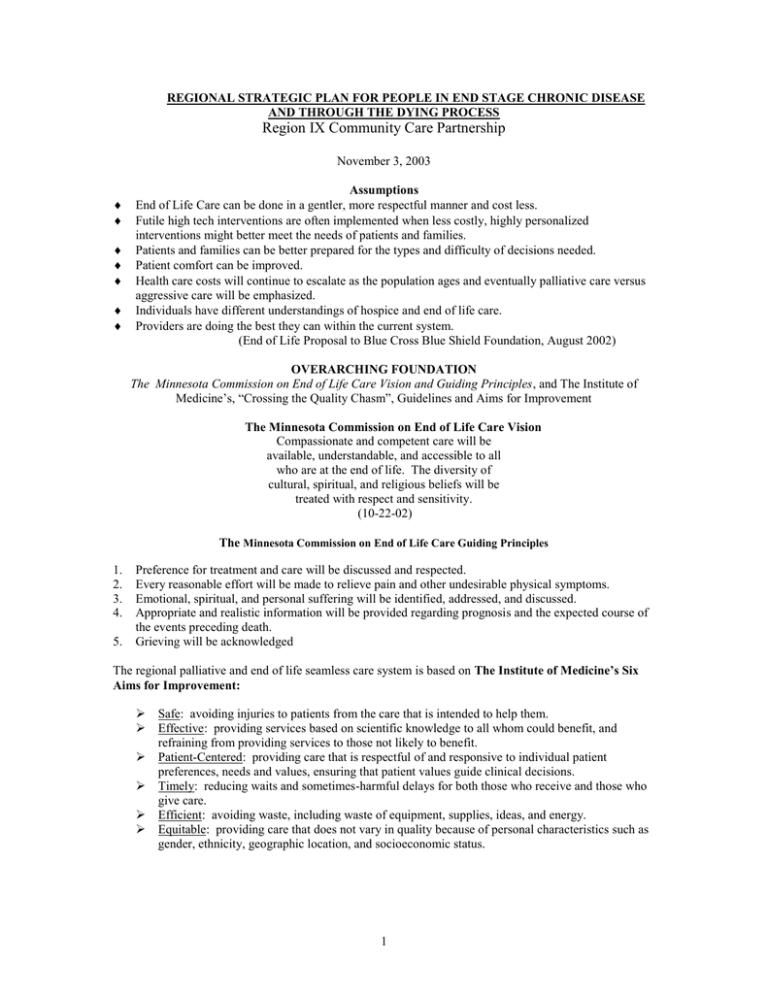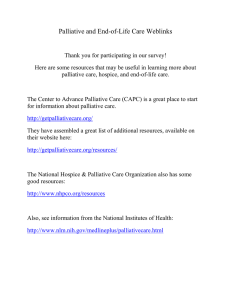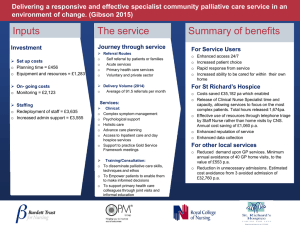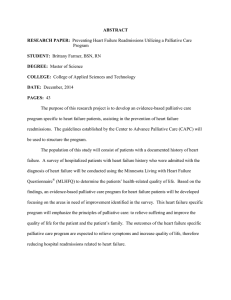Region IX Community Care Partnership
advertisement

REGIONAL STRATEGIC PLAN FOR PEOPLE IN END STAGE CHRONIC DISEASE AND THROUGH THE DYING PROCESS Region IX Community Care Partnership November 3, 2003 Assumptions End of Life Care can be done in a gentler, more respectful manner and cost less. Futile high tech interventions are often implemented when less costly, highly personalized interventions might better meet the needs of patients and families. Patients and families can be better prepared for the types and difficulty of decisions needed. Patient comfort can be improved. Health care costs will continue to escalate as the population ages and eventually palliative care versus aggressive care will be emphasized. Individuals have different understandings of hospice and end of life care. Providers are doing the best they can within the current system. (End of Life Proposal to Blue Cross Blue Shield Foundation, August 2002) OVERARCHING FOUNDATION The Minnesota Commission on End of Life Care Vision and Guiding Principles, and The Institute of Medicine’s, “Crossing the Quality Chasm”, Guidelines and Aims for Improvement The Minnesota Commission on End of Life Care Vision Compassionate and competent care will be available, understandable, and accessible to all who are at the end of life. The diversity of cultural, spiritual, and religious beliefs will be treated with respect and sensitivity. (10-22-02) The Minnesota Commission on End of Life Care Guiding Principles 1. 2. 3. 4. 5. Preference for treatment and care will be discussed and respected. Every reasonable effort will be made to relieve pain and other undesirable physical symptoms. Emotional, spiritual, and personal suffering will be identified, addressed, and discussed. Appropriate and realistic information will be provided regarding prognosis and the expected course of the events preceding death. Grieving will be acknowledged The regional palliative and end of life seamless care system is based on The Institute of Medicine’s Six Aims for Improvement: Safe: avoiding injuries to patients from the care that is intended to help them. Effective: providing services based on scientific knowledge to all whom could benefit, and refraining from providing services to those not likely to benefit. Patient-Centered: providing care that is respectful of and responsive to individual patient preferences, needs and values, ensuring that patient values guide clinical decisions. Timely: reducing waits and sometimes-harmful delays for both those who receive and those who give care. Efficient: avoiding waste, including waste of equipment, supplies, ideas, and energy. Equitable: providing care that does not vary in quality because of personal characteristics such as gender, ethnicity, geographic location, and socioeconomic status. 1 Expected Outcome of Strategic Plan: Creation of a health care system that is patient directed, and in which consumers are educated to direct their care. Goal 1: Create a regional, culturally sensitive, seamless care system for Palliative and End of Life Care Action Steps Develop, implement and evaluate a three-five year demonstration project in partnership with providers, payers, long-term care, and multiple community partners (including but not limited to spiritual care givers, bankers, estate planners, financial planners, and lawyers). Implement increased palliative care options and the seamless flow between curative, palliative and hospice care as directed by the patient. Integrate care coordination as a key reimbursable component of the seamless care demonstration project. Implement culturally sensitive advanced care planning tools to provide guidance for difficult end of life discussions and decisions. Improve care through access to a portable, pertinent health record. Promote hospice as a choice in end of life care. Anticipated Results: Care will be based on continuous healing relationships Care will be customized according to patient needs and values The patient will be the source of control Knowledge will be shared and information will flow freely Decision making will be evidence based There will be increased utilization of palliative and hospice care There will be increased collaboration among providers There will be reduced cost and higher patient/family satisfaction Timeline: Responsible Party: Goal 2: Develop and deliver education to improve seamless Palliative and End of Life Care Action Steps Identify stakeholders who will develop and support education plan for end of life care. Design and develop regional culturally sensitive ongoing end of life education, including tailored curricula for practitioners, family caregivers, patients, community professionals (including, but not limited to spiritual care givers, bankers, estate planners, financial planners, lawyers, extension agents, insurance salespersons, human resource persons), and volunteers. Develop and implement mass-market promotion for advance care planning tools. Develop and train a cadre of mentors for family caregivers (nonprofessional/family) to support those dealing with end of life care. Anticipated Results Stakeholders will be identified and educated Education to improve seamless palliative and end of life care will be delivered Improved satisfaction of patient, family, health care providers and payors Reduced system costs Timeline: Responsible Party: 2



